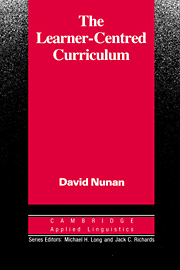Book contents
- Frontmatter
- Contents
- Series Editors' Preface
- Preface
- 1 Introduction
- 2 Curriculum Processes
- 3 Learner-Centred Curriculum Development
- 4 Pre-Course Planning Procedures
- 5 Planning Content
- 6 Methodology
- 7 Resources for a Learner-Centred Curriculum
- 8 Assessment and Evaluation
- 9 Evaluation and Professional Development
- 10 The Teacher as Curriculum Developer
- References
- Appendix
- Subject Index
- Author Index
9 - Evaluation and Professional Development
Published online by Cambridge University Press: 05 April 2013
- Frontmatter
- Contents
- Series Editors' Preface
- Preface
- 1 Introduction
- 2 Curriculum Processes
- 3 Learner-Centred Curriculum Development
- 4 Pre-Course Planning Procedures
- 5 Planning Content
- 6 Methodology
- 7 Resources for a Learner-Centred Curriculum
- 8 Assessment and Evaluation
- 9 Evaluation and Professional Development
- 10 The Teacher as Curriculum Developer
- References
- Appendix
- Subject Index
- Author Index
Summary
Introduction
Within a learner-centred system, the teacher has a central role to play in all aspects of the curriculum. In systems based on traditional curriculum models, the teacher is very often reduced to the role of servant to a centralised curriculum process in which decisions about what will be taught, how it will be taught and how learner assessment and course evaluation will be conducted are made, not by teachers, but by some authority remote from the point of course delivery.
In a learner-centred system, such centralised direction is undesirable. It is also hardly feasible, as a central assumption of the learner-centred philosophy is that differentiated curricula will have to be developed to respond to differentiated learner needs, the differentiation occurring along many different dimensions. Even curricula which share common linguistic content may well be differentiated in terms of topics, themes, situations, methodology, materials, learning tasks and activities, learning arrangements, means of assessment and so on.
In this work, I have attempted to view curriculum processes from a number of different perspectives. Minimally, the curriculum can be seen as a plan of action (the planned curriculum), as a description of what actually happens in classrooms (the implemented curriculum), and as an analysis and description of what learners actually learn (the assessed curriculum). (See also Bartlett and Butler's (1985) comprehensive curriculum model.) The planned curriculum relates to what is set down in curriculum documents and plans; the implemented curriculum is what actually happens during the teaching learning process; and the assessed curriculum is what the learners actually learn.
- Type
- Chapter
- Information
- The Learner-Centred CurriculumA Study in Second Language Teaching, pp. 136 - 150Publisher: Cambridge University PressPrint publication year: 1988



